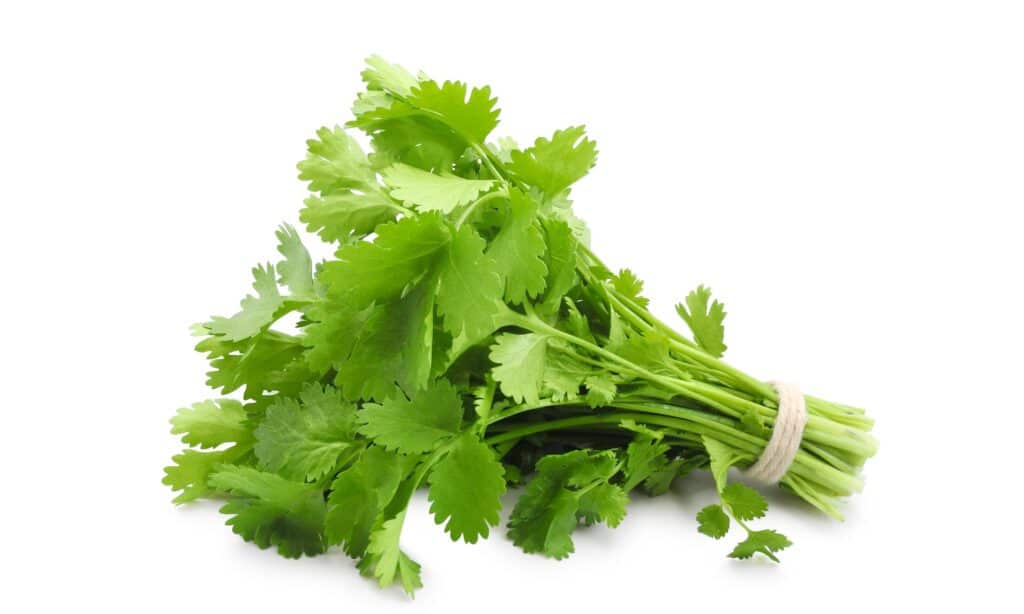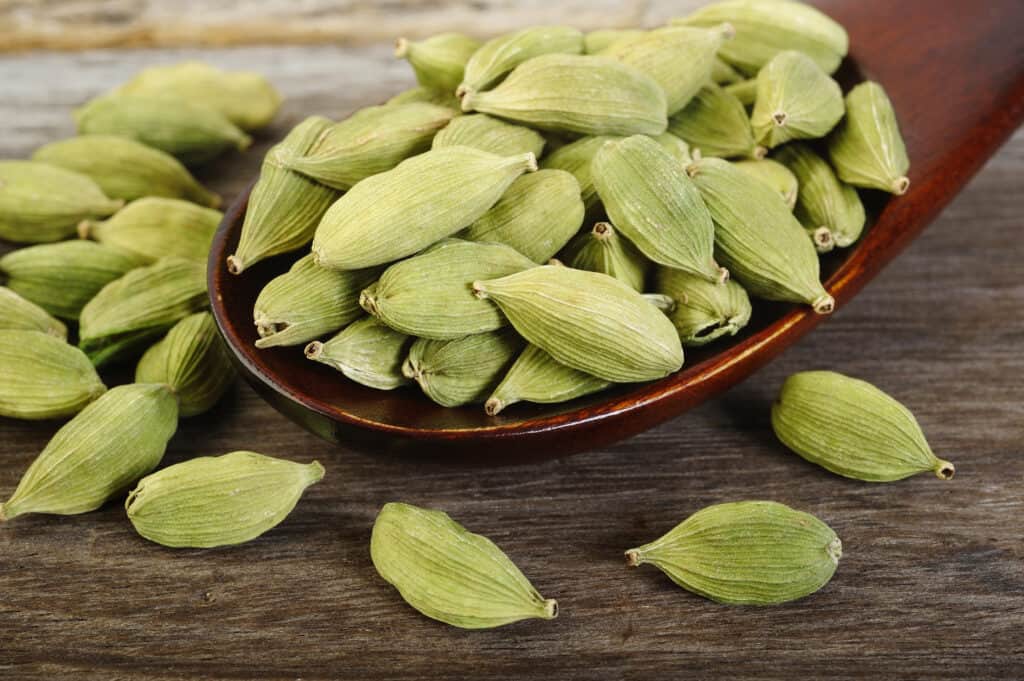Cardamom vs. coriander: many people use them interchangeably in the kitchen, yet they are very different! Let’s explore the differences between cardamom and coriander.
Cardamom vs. Coriander: What’s the Difference?
Nomenclature
Coriander is a herbaceous plant in the Apiaceae family. There are many differences between cardamom and coriander, starting with the scientific nomenclature. Contrarily, cardamom is a blend of the seeds of several plants in the Zingiberaceae family.
Additionally, coriander can be known by many common names, such as “Chinese parsley,” “dhania,” or “cilantro.” Unfortunately, cardamom doesn’t have many common names. However, the name is sometimes spelled “cardamum.” So, don’t be surprised if you see both spellings.

Elettaria cardamomum, commonly known as green cardamom.
©muralird2008/Shutterstock.com
Varieties
There are also different varieties of cardamom. Green cardamom is the most common variety of cardamom in the West, and it’s also the most expensive by weight. Black cardamom is less common as it’s not grown as extensively as green cardamom. White cardamom is bleached green cardamom. There is also a variety of white cardamom known as Siam cardamom, which is similar to green cardamom in genetics but has a different taste.
There are three species of coriander in the genus Coriandrum. However, only Coriandrum sativum is for commercial use.

Cilantro is widely used as a garnish.
©iStock.com/Yana Boiko
Cardamom vs. Coriander: Taste
As both plants are herbaceous, comparing their taste in dishes is crucial. Coriander and cardamom are both sweet and have similar taste profiles. However, cardamom’s taste is significantly stronger than coriander’s. Cardamom may be expensive and difficult to use due to its short shelf life (exposed or ground-up seeds will lose their flavor quickly). In addition, its strong taste means very few powdered seeds are necessary.
Cardamom seeds are usually loved, while coriander seeds receive mixed reviews. Scientists think this is because some people carry the OR6A2 gene, which causes the aldehyde receptors in the mouth to register the taste as being like soap or bugs.
How to Grow Coriander in Your Home Garden
If you don’t carry the OR6A2 gene and love the taste, you might wonder if you can grow coriander in your home garden. The good news is that you can! All parts of the coriander plant are edible too! Coriander is a relatively easy-to-grow plant used to cook fresh or dried.
For starters, you can sow coriander seeds from June until September. Don’t sow any seeds after September, though, as the plants won’t grow in time to be harvested before they die. You can do this in June or July if you want to plant an immature coriander plant. Still, the plant won’t effectively propagate if planted later than that.
When sowing coriander seeds, it’s essential to choose a good location. Coriander does best placed in full sun. Avoid sowing your plants in shady areas, as they will not grow correctly, if at all. Coriander seeds can be slow to germinate. Some gardeners recommend gently crushing the seeds to hasten germination. With or without crushing them, the seeds should germinate within 7–20 days.
Growth Tips
Coriander plants do not grow back once they’ve been harvested or died. So, you’ll need to continue sowing seeds throughout the summer to keep a constant supply. In addition, you’ll want to thin out the seeds once they start growing to ensure that the plants don’t grow into each other and kill each other by accident. Ideally, each plant in your garden should be about 25 cm from any adjacent plants.
Additionally, you’ll need to water the plants frequently. A good rule of thumb is that the soil should be damp, not moist or wet. Dry soil can cause coriander plants to flower prematurely, ending their usefulness as a herb. However, ensure that you don’t accidentally overwater them while doing so.
It takes about a month for coriander plants to produce seeds and leaves. So your earliest yield will be in July if you sowed seeds in June.
How to Grow Cardamom in Your Garden
Cardamom is a little more challenging to grow than coriander. This is because cardamom spice is made up of the seeds of two different genera of plants in the same family and partially because the plant’s harvesting process is so labor-intensive. For starters, you’ll need to determine what type of cardamom you’re growing.
Green cardamom is by far the most popular type of cardamom. However, it’s also high on the list of the most expensive spices. It also can’t be stored like other spices. The seed pods must be kept fresh, or the cardamom’s flavor will disappear.
White cardamom typically refers to bleached green cardamom, while black cardamom is an entirely different plant. This article focuses on green cardamom, but know that it’s possible to grow black cardamom in your garden.
Cardamom will only grow in USDA Hardiness Zones 10 and 11. So, unfortunately, for people who live north or south of the equator, this plant won’t do well in your garden. An alternative would be to plant cardamom into a pot and bring it indoors.
Unlike coriander, which prefers full sun, cardamom prefers partial shade as it’s a forest-dwelling plant. Planting this plant in full sun could result in the leaves burning. So you’ll want to make sure this plant gets enough shade throughout the day.

Green cardamom pods.
©jeehyun/Shutterstock.com
Cardamom vs. Coriander: Final Thoughts
Cardamom and coriander might taste similar, but they’re very different plants. They have different needs that should be considered when growing them, and they’re used differently in cooking. Unfortunately, they’re not beginner-friendly plants, and cardamom seeds can be expensive. Still, they’re an excellent addition to your spice rack.
The photo featured at the top of this post is © iStock.com/Tevarak
Sources
- Wikipedia, Available here: https://en.wikipedia.org/wiki/Cardamom
- Wikipedia, Available here: https://en.wikipedia.org/wiki/Coriander
- Healthline, Available here: https://www.healthline.com/nutrition/cardamom-benefits
- Utah State University, Available here: https://extension.usu.edu/yardandgarden/research/cilantro-coriander-in-the-garden
- University of Wisconsin Madison, Available here: https://hort.extension.wisc.edu/articles/cilantro-coriander-coriandrum-sativum/
FAQs (Frequently Asked Questions)
What part of the coriander plant is edible?
The entire coriander plant is edible.
Why does coriander taste like soap?
Coriander tastes like soap to some people because the aldehydes in coriander are similar to soap. However, these aldehydes are also found in the bug family of insects, so coriander can also taste like bugs to some people
Does coriander taste like soap?
Some people find that coriander tastes like soap when they eat it.
Are coriander and cilantro the same plant?
Yes. The names coriander and cilantro refer to the same plant.
Are cardamom and coriander the same plant?
No. Three species of cardamom are cultivated for commercial use: green cardamom, black cardamom, and white cardamom. Coriander is a different plant altogether.
Thank you for reading! Have some feedback for us? Contact the AZ Animals editorial team.






